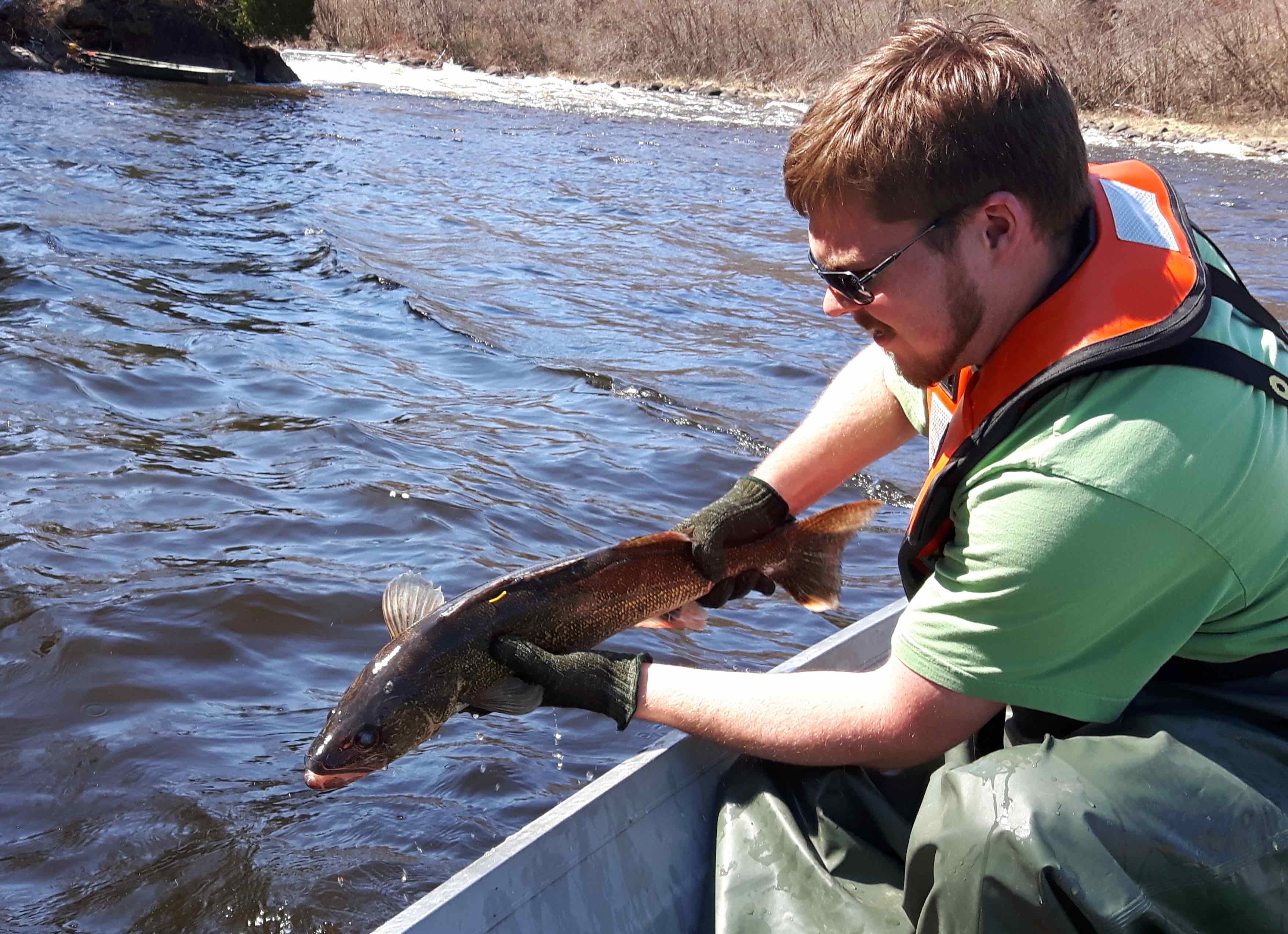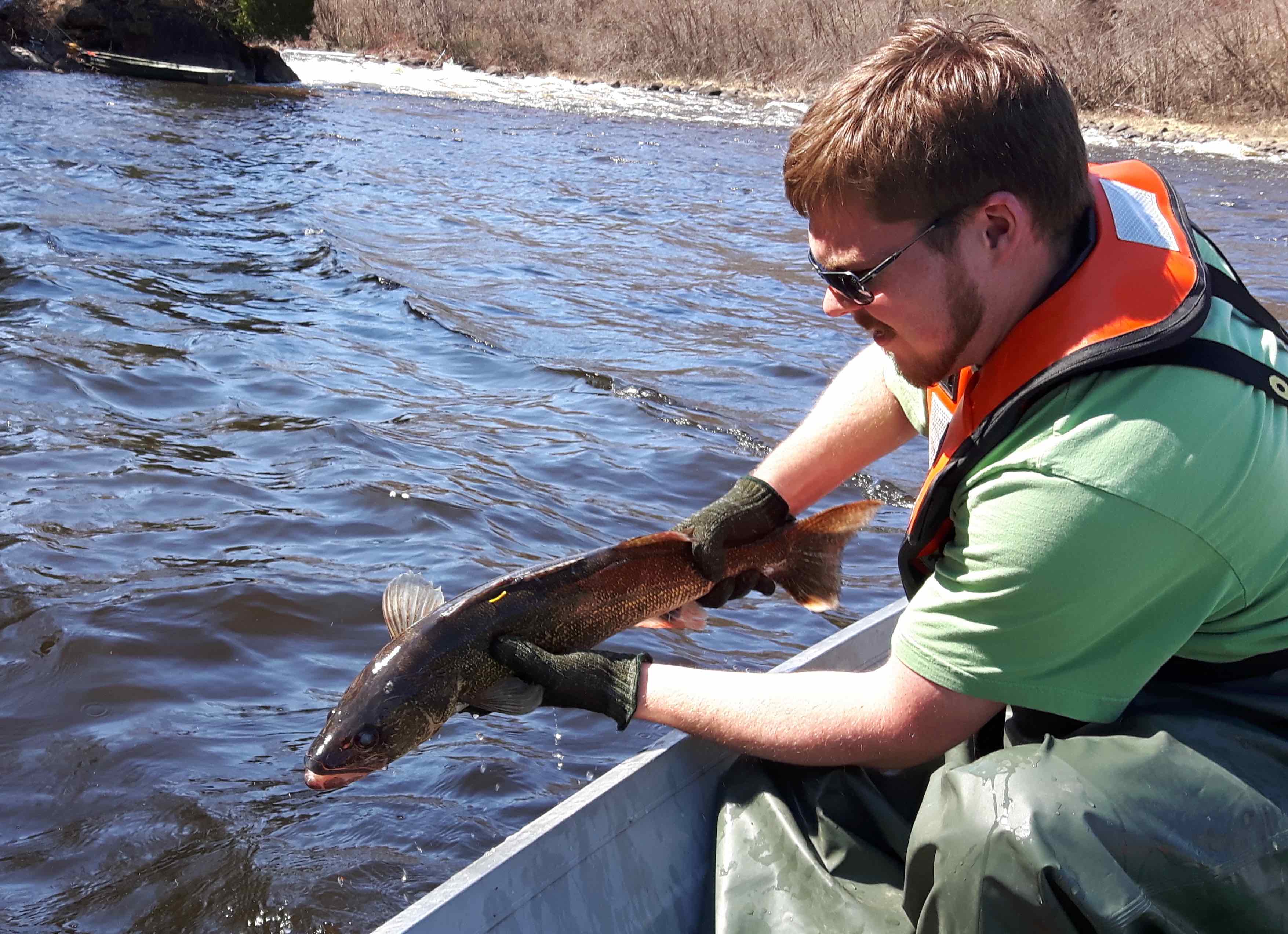Research in Action: Lakehead professor assessing walleye movement in Black Bay

Photo cutline: Lakehead University graduate student Graydon McKee returns an acoustically-tagged walleye that will be tracked to assess its movement in Black Bay.
Published in The Chronicle Journal on Saturday, July 21, 2018
Decades after the collapse of a fish species in an area east of Thunder Bay, researchers are hoping walleye will make a comeback someday.
Early results from a study in Black Bay suggest a great deal of movement in and out of the no-fishing zone, meaning a re-evaluation of the situation may be in order.
“What’s your management strategy?” asks Lakehead University’s Dr. Michael Rennie. “Protect the whole bay from angling in order to speed up recovery of the species or keep one small portion closed? You might change your management strategy based on an understanding of how fish move seasonally.”
An assistant professor in Biology and Canada Research Chair in Freshwater Ecology and Fisheries, Rennie is involved in a collaborative project with Ontario’s Ministry of Natural Resources and Forestry to assess walleye movement in Black Bay. Master’s student Graydon McKee is analyzing data from walleye fitted with acoustic tags to analyze and track their movement throughout the bay. He also collects biological samples to assess growth and feeding patterns.
Black Bay is unique because, unlike much of Lake Superior, it is shallow, relatively warm and murky, making it an ideal habitat for walleye. The researchers have found two distinct groups of walleye in the bay: migrators and residents. Some walleye leave during the summer (following spawning) and return in the fall, while another group stays the year round.
“When looking at growth patterns, the migratory fish grow larger than their resident counterparts,” McKee states.
This may be due to the type of food available outside of Black Bay. But a more definitive analysis awaits.
The species suffered a major collapse in the late 1960s. From the line that now represents the no-fishing sanctuary in the bay, 70 per cent of the fish that are tagged actually move out of the sanctuary.
“So it might represent some kind of refuge,” Rennie says. “But if you think it protects the walleye we have in the system, well, they’re moving around quite a lot, so the fishing ban doesn’t protect fish if they are angled when they leave the sanctuary.”
Black Bay walleye movement is one of several projects Rennie is involved with focusing on lakes and how they respond to climate warming, invasive species and contaminants.
As lead researcher of the Community Ecology and Energetics Lab, much of Rennie’s work is located at ISD Experimental Lakes Area (IISD-ELA), a set of 58 lakes and their watersheds just outside Kenora that are dedicated to experimentation on whole lakes. A unique kind of real-world laboratory, it is the only place of its kind in the world.
Rennie is completing a project with Trent University examining nanosilver, an understudied substance that can be found in everything from athletic clothing and socks to coatings on cutting boards. Initially, it was thought this anti-microbial would impact the lower food web, such as algae and zooplankton.
“What we found was quite the opposite,” Rennie says. “We found most of the impacts were on fish rather than organisms lower in the food web. They were eating less in the presence of this silver, and smaller/younger fish were growing slower.”
It is hoped the results will spur regulators to limit the amount of nanosilver being released into the environment.
Other work at IISD-ELA shows that lakes recovering from acid rain have lake trout populations that are stunted, less abundant and have high levels of mercury. That could be due to the absence of a freshwater shrimp called Mysis diluviana, on which the trout feed, which were eliminated from the lake during acidification. This year an experiment is being launched to add Mysis back into the lake to see if it improves trout populations.
Rennie is also looking for Mysis DNA in the lake sediment (or environmental DNA) from the acidified lake to see if this technology can be applied to other affected lakes.
“You can now use the sediment to ask the question: what used to be here before we messed the system up?” Rennie says. “It will help managers set restoration targets. If you’re introducing species to ecosystems, you want to put back what was there already, which you might not have information on. We’re trying to use the DNA trapped in sediments from this lake as a case study for how you can apply this technology to other impacted lakes in Ontario.”


